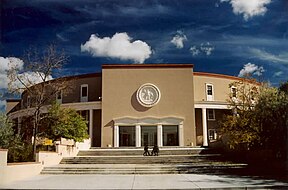The Southern Rocky Mountain Front is a megaregion of the United States, otherwise known as a megalopolis, with population centers consisting mainly of the Front Range Urban Corridor and the Albuquerque–Santa Fe–Los Alamos combined statistical area, located along the eastern and southern face of the Southern Rocky Mountains in the U.S. states of Wyoming, Colorado, and New Mexico. The region comprises the southern portion of the Rocky Mountain Front geographic region of Canada and the United States, extending into the Southwestern United States. The Southern Rocky Mountain Front had a population of 5,467,633 according to the 2010 United States census.[2] The region is one of the fastest-growing regions in the United States, and its population is projected to grow by 87% to 10,222,370 by 2050.[3] In 2005 the GDP of the region was $229,202,000,000 making up 2% of the United States GDP.[3]
Southern Rocky Mountain Front | |
|---|---|
State capitols in the megaregion (from top to bottom) Wyoming State Capitol in Cheyenne Colorado State Capitol in Denver New Mexico State Capitol in Santa Fe | |
 | |
| Country | |
| States | |
| Largest city | - Denver |
| Other principal cities |
|
| Population | 5,467,633 |
| Time zone | UTC−7 (MST) |
| • Summer (DST) | UTC−6 (MDT) |
Extent
editThe Southern Rocky Mountain Front stretches from Albuquerque, New Mexico, north along Interstate Highway 25 to Cheyenne, Wyoming, and includes the Denver-Aurora-Lakewood, CO Metropolitan Statistical Area, the Colorado Springs, CO Metropolitan Statistical Area, the Boulder, CO Metropolitan Statistical Area, the Fort Collins, CO Metropolitan Statistical Area, the Greeley, CO Metropolitan Statistical Area, the Pueblo, CO Metropolitan Statistical Area, the Cheyenne, WY Metropolitan Statistical Area, the Cañon City, CO Micropolitan Statistical Area, the Albuquerque, NM Metropolitan Statistical Area, and the Santa Fe, NM Metropolitan Statistical Area.[3] The region comprises three primary subregions: the South Central Colorado Urban Area, the North Central Colorado Urban Area, and the Cheyenne Metropolitan Area.
The influence of the region extends well beyond its defined boundaries. The Colorado Eastern Plains, Nebraska Panhandle and Albany County, Wyoming, among other areas, are culturally and economically tied to the region, though they are not considered a part of it.
Transportation
editRail
editThe region was established, along with ten other megaregions throughout the United States, by America 2050 in response to President Barack Obama’s efforts to improve the country’s infrastructure. The megaregions were initially identified by America 2050 as areas that should have highspeed rail by 2050.[5] According to America 2050’s four phase plan the Front Range would have highspeed rail on Phase 3 of the plan and the line would stretch from Denver, Colorado to Albuquerque, New Mexico.[6]
Interstates and highways
editInterstate 25 runs through the Southern Rocky Mountain Front north from Albuquerque, NM to Cheyenne, WY. Major east and west routes running through the region are I-40 through Albuquerque, I-70 through Denver, and I-80 through Cheyenne.
- Interstate 25 runs north–south from New Mexico through Denver to Wyoming
- Interstate 70 runs east–west through the region from Utah to Maryland
- Interstate 80 runs east–west through the region from California to New Jersey
- Interstate 40 runs east–west through the region from California to North Carolina
Airports
editThe region has seven airports offering passenger services with two of the airports, Albuquerque International Sunport and Denver International Airport, able to handle international flights.
List of airports offering passenger services
edit| Airport | Aircraft operations | Passengers |
|---|---|---|
| Albuquerque International Sunport | 192,520 | 5,801,641 |
| Cheyenne Regional Airport | 65,163 | |
| Colorado Springs Airport | 153,244 | |
| Denver International Airport | 635,445 | 53,156,278 |
| Pueblo Memorial Airport | 182,119 | |
| Laramie Regional Airport | 10,486 | |
| Santa Fe Municipal Airport | 78,569 |
Municipalities
editSee also
edit- Southern Rocky Mountain Front
- Colorado
- Conurbation
- List of census-designated places in Colorado
- List of census-designated places in New Mexico
- List of census-designated places in Wyoming
- List of cities and towns in Colorado
- List of cities and towns in New Mexico
- List of cities and towns in Wyoming
- List of counties in Colorado
- List of counties in New Mexico
- List of counties in Wyoming
- List of places in Colorado
- Megaregions of the United States
- New Mexico
- Rocky Mountain Front
- Southern Rocky Mountains
- Statistical area (United States)
- Wyoming
References
edit- ^ Not included is Albuquerque and Northern New Mexico due to size constraints. Northern New Mexico is included per "Megaregions". America2050. USA: Regional Plan Association. Archived from the original on April 30, 2009. Retrieved December 7, 2014. Home page of the historic America 2050 program of the RPA.
- ^ a b c "County Totals Datasets: Population, Population Change and Estimated Components of Population Change: April 1, 2010 to July 1, 2012". 2012 Population Estimates. United States Census Bureau, Population Division. March 2013. Archived from the original on July 7, 2013. Retrieved May 23, 2013.
- ^ a b c "Reports". Archived from the original on 2017-07-26. Retrieved 2013-08-13.
- ^ "OMB Bulletin No. 10-02: Update of Statistical Area Definitions and Guidance on Their Uses" (PDF). United States Office of Management and Budget. December 1, 2009. Archived (PDF) from the original on January 21, 2017. Retrieved May 5, 2011.
- ^ "Reports". Archived from the original on 2017-05-16. Retrieved 2013-08-15.
- ^ "Reports".
- ^ The City of Centennial, Colorado was incorporated on February 7, 2001.
External links
edit- United States Census Bureau
- U.S. population estimates at the Library of Congress Web Archives (archived 2006-12-06)


